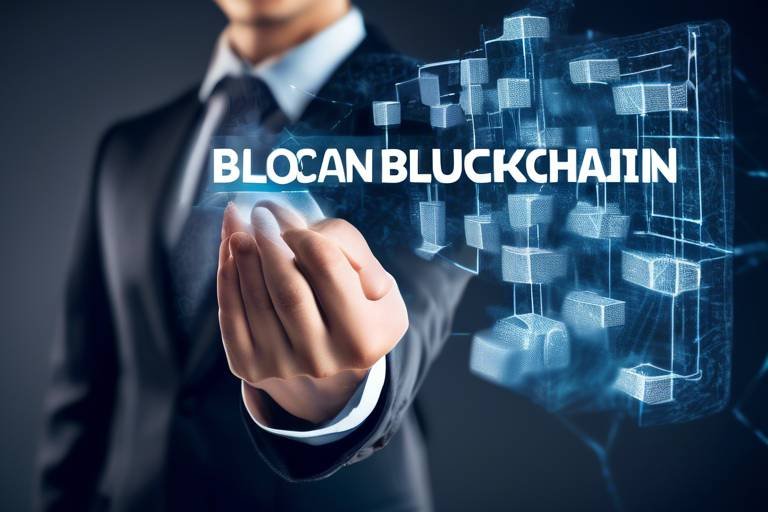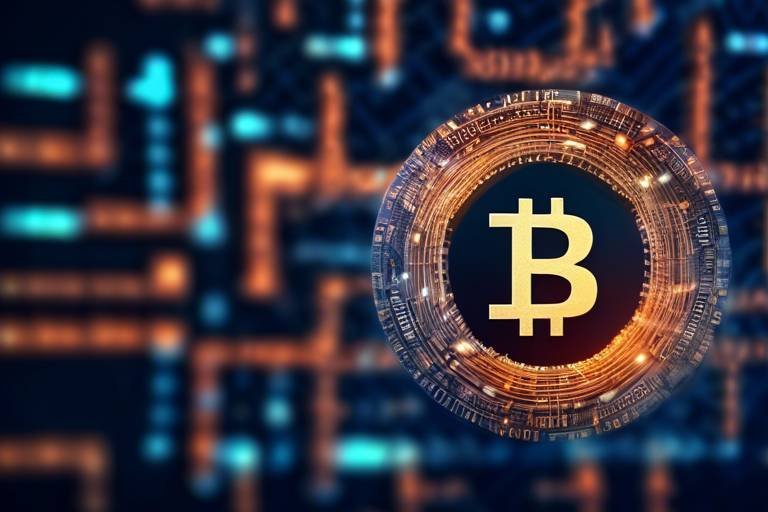The Role of Blockchain in Enhancing Traceability in Food Supply
In an age where food safety and transparency are more crucial than ever, the integration of blockchain technology into the food supply chain is revolutionizing the way we track and trace food products. Imagine biting into a juicy apple and knowing exactly where it came from, how it was grown, and who handled it along the way. Sounds like something out of a sci-fi novel, right? But with blockchain, this is becoming a reality. By providing a decentralized, immutable ledger of transactions, blockchain enhances traceability from the farm to your table, ensuring that every bite is not only delicious but also safe and trustworthy.
Blockchain works by recording every transaction in a transparent manner, making it nearly impossible to alter the data without consensus from all parties involved. This means that every step of the food supply chain—from the moment a seed is planted to the delivery of the final product—can be tracked and verified. This level of transparency is essential in today's world, where food recalls and safety concerns are prevalent. With blockchain, stakeholders can quickly identify the source of contamination or fraud, minimizing risks and protecting consumers.
Moreover, the benefits of blockchain extend beyond just safety. It enhances efficiency and reduces costs by streamlining processes and eliminating the need for intermediaries. Imagine a world where farmers, distributors, retailers, and consumers can all access the same real-time information about a food product. This not only accelerates the response time in case of issues but also fosters a sense of trust among all parties involved. It’s like having a GPS for food; everyone knows where it’s been and where it’s going, ensuring a smooth journey from farm to table.
But let’s not overlook the potential for consumer empowerment. With blockchain, consumers can scan a QR code on their food packaging and instantly access detailed information about the product's history. This empowers them to make informed choices about what they eat, leading to a more conscious and responsible consumer base. In a world where consumers are increasingly concerned about sustainability and ethical practices, having access to this information can significantly influence purchasing decisions.
As we delve deeper into the intricacies of blockchain technology and its role in enhancing traceability in the food supply chain, we will explore the challenges faced by traditional systems, the innovative solutions blockchain offers, and real-world applications that showcase its effectiveness. The future of food traceability is not just bright; it’s blockchain-bright!
- What is blockchain technology?
Blockchain is a decentralized digital ledger that records transactions across multiple computers, ensuring that the data is secure and cannot be altered without consensus.
- How does blockchain improve food traceability?
By providing a transparent and immutable record of every transaction in the food supply chain, blockchain enhances traceability, ensuring food safety and quality.
- What are the benefits of using blockchain in the food industry?
Benefits include improved safety, efficiency, reduced costs, and enhanced consumer trust through transparency.
- Can consumers access information about their food through blockchain?
Yes, consumers can use QR codes to access detailed information about the food products they purchase, empowering them to make informed choices.

Understanding Blockchain Technology
Blockchain technology is often described as a decentralized digital ledger that records transactions across multiple computers in a way that ensures the security and transparency of the data. Imagine a digital notebook that everyone can see, but no one can erase or alter the entries. This characteristic makes blockchain incredibly powerful, especially in industries like food supply chains where traceability and accountability are paramount.
The core principles of blockchain revolve around three main components: decentralization, transparency, and security. Decentralization means that no single entity controls the entire system; instead, it is distributed among all participants. This reduces the risk of fraud and manipulation. Transparency allows all stakeholders to access the same information in real-time, which is crucial for tracking food products from farm to table. Lastly, security is ensured through cryptographic techniques that protect the data from unauthorized access or tampering.
To better understand how blockchain can be applied, let’s break down its components:
- Blocks: Each block contains a list of transactions, a timestamp, and a cryptographic hash of the previous block, linking them together.
- Nodes: These are the individual computers that participate in the blockchain network. Each node has a copy of the entire blockchain, ensuring that the data is not lost and is accessible to all.
- Consensus Mechanisms: These are protocols that ensure all nodes agree on the validity of transactions before they are added to the blockchain, preventing fraudulent activities.
In the context of food supply chains, blockchain can drastically improve the way we track the journey of food products. From the moment a crop is harvested to when it reaches your plate, every step can be recorded on the blockchain. This creates a complete history of the product, which can be invaluable during food safety investigations or recalls. If a batch of lettuce is found to be contaminated, blockchain allows for quick identification of the affected products and their distribution channels.
Moreover, the immutable nature of blockchain means that once information is entered, it cannot be changed or deleted. This provides an added layer of trust, as consumers can verify the origins of their food and the practices employed in its production. For instance, if a consumer wants to know whether their chicken was raised free-range or the conditions it was kept in, blockchain can provide that information at the click of a button.
In conclusion, understanding blockchain technology is essential for recognizing its transformative potential in enhancing traceability in the food supply chain. By leveraging its core principles of decentralization, transparency, and security, stakeholders can work together to create a more reliable and efficient food system. As we delve deeper into the importance of traceability in food supply, it becomes clear that blockchain is not just a buzzword; it’s a game-changer.

Importance of Traceability in Food Supply
When it comes to food, we all want to know where it comes from, right? Traceability in the food supply chain is not just a buzzword; it's a necessity. Imagine biting into a delicious apple, only to find out later that it was part of a contaminated batch. Scary, isn't it? That's why traceability is crucial. It ensures that every step of the food journey—from the farm to your table—is documented and transparent.
Traceability plays a vital role in maintaining food safety. It allows stakeholders to track and trace food products throughout the supply chain, which is essential for identifying the source of contamination quickly. For instance, if a foodborne illness outbreak occurs, traceability helps in pinpointing the exact origin of the contaminated food, enabling swift action to remove it from the market. This not only protects consumers but also helps businesses avoid costly recalls and reputational damage.
Moreover, traceability is key to ensuring quality and compliance with regulations. The food industry is heavily regulated, and being able to demonstrate compliance with safety standards is paramount. With a robust traceability system, companies can provide evidence that their products meet quality standards and are safe for consumption. This is particularly important for businesses that export food products to different countries, as each may have its own set of regulations.
In addition to safety and compliance, traceability fosters consumer trust. In today’s market, consumers are increasingly concerned about the origins of their food. They want to know if it's organic, free from harmful chemicals, or sourced sustainably. By providing transparent information about the food supply chain, companies can build stronger relationships with their customers. Trust is everything, and when consumers feel confident about what they are eating, they are more likely to remain loyal to a brand.
To sum it up, the importance of traceability in the food supply chain cannot be overstated. It not only enhances food safety and compliance but also builds consumer trust. As we continue to navigate a world that's increasingly focused on sustainability and health, traceability will become even more critical. It’s no longer just about getting food from point A to point B; it’s about ensuring that every step along the way is transparent and accountable.
In the next section, we will dive deeper into the challenges faced in traditional traceability systems, highlighting the need for innovative solutions like blockchain technology.
- What is food traceability?
Food traceability is the ability to track and trace the history, application, or location of food products through the supply chain.
- Why is traceability important?
It is important for ensuring food safety, maintaining quality, complying with regulations, and building consumer trust.
- How does blockchain improve traceability?
Blockchain enhances traceability by providing a secure, decentralized ledger that records all transactions in real-time, making it easier to track food products.

Challenges in Traditional Traceability Systems
When we think about the food we consume, it’s easy to take for granted the journey it has taken to reach our plates. However, traditional traceability systems are often riddled with challenges that can compromise food safety and quality. One of the most significant issues is the presence of data silos. These silos occur when information is stored in isolated systems, making it difficult for various stakeholders—such as farmers, distributors, and retailers—to access and share critical data. Imagine trying to piece together a puzzle with missing pieces; that’s what it’s like when data isn’t readily available across the supply chain.
Moreover, the lack of real-time information can lead to delays in identifying issues such as contamination or spoilage. For instance, if a batch of produce is found to be contaminated, the ability to trace back through the supply chain quickly is essential to prevent further distribution. Unfortunately, traditional systems often rely on manual processes and outdated technology, which can slow down response times and hinder effective decision-making. As a result, not only does this impact food safety, but it also affects consumer trust.
Another challenge is the complexity of supply chains. The food supply chain is often convoluted, involving multiple parties at different stages—from farms to processing plants to retailers. This complexity can lead to inconsistencies in record-keeping and tracking, making it easier for errors to occur. For example, if a farmer fails to log the use of pesticides accurately, it can lead to serious consequences down the line, affecting both safety and compliance with regulations.
Furthermore, consumer trust is increasingly at risk due to inadequate traceability. In today’s market, consumers are more concerned than ever about the origins of their food. They want to know where it comes from, how it was produced, and whether it’s safe to eat. If there are gaps in the traceability of food products, it can erode confidence and lead to skepticism about the integrity of food brands. According to recent surveys, a significant percentage of consumers would be willing to pay more for products that offer transparency and traceability. This highlights the importance of addressing these traditional system challenges to meet consumer demands.
In summary, the challenges faced by traditional traceability systems—such as data silos, lack of real-time information, complex supply chains, and consumer trust issues—pose significant risks to food safety and quality. Addressing these challenges is crucial for ensuring a safer food supply chain that can withstand the scrutiny of modern consumers.

Data Silos and Inefficiencies
In the complex world of the food supply chain, data silos pose a significant challenge that can hinder the efficiency and reliability of traceability systems. Imagine a scenario where various stakeholders—farmers, processors, distributors, and retailers—are all working with their own isolated databases. This disjointed approach creates a fragmented view of the supply chain, making it nearly impossible to track a product’s journey from farm to table accurately. The lack of a unified system leads to inefficiencies that can have serious repercussions.
When data is trapped in silos, it becomes challenging to share critical information in real-time. For example, if a contamination issue arises in a specific batch of produce, the ability to swiftly trace its origins is compromised. Stakeholders may not have immediate access to the necessary data to identify affected products, leading to delays in response and potentially putting consumer safety at risk. This situation can escalate quickly, resulting in costly recalls and damaging the brand's reputation.
Moreover, the inefficiencies stemming from data silos can manifest in several ways:
- Delayed Decision-Making: Without real-time data sharing, stakeholders may struggle to make informed decisions quickly, which can lead to missed opportunities or prolonged issues.
- Inaccurate Reporting: Isolated data may not reflect the full picture, resulting in miscommunication and errors in reporting, which can affect compliance with regulations.
- Increased Costs: The inefficiencies caused by data silos often lead to higher operational costs due to redundancies and the need for additional resources to manage and reconcile disparate data sources.
Ultimately, these challenges highlight the urgent need for a more integrated approach to data management within the food supply chain. By leveraging technologies like blockchain, stakeholders can break down these silos, enabling seamless data sharing and fostering a more transparent and efficient system. This shift not only enhances traceability but also builds trust among consumers, who increasingly demand transparency regarding the origins of their food.

Consumer Trust Issues
In today's world, where food safety scandals seem to pop up more frequently than the latest viral trends, consumer trust has become a fragile commodity. Imagine walking into a grocery store, staring at a shelf filled with vibrant fruits and vegetables, and wondering, "How safe is this food?" This uncertainty can be overwhelming, and it often stems from inadequate traceability in the food supply chain. When consumers can't trace the journey of their food from farm to table, they may feel hesitant to trust the products they purchase.
One of the biggest issues that arise from a lack of transparency is the fear of contamination. For instance, if a foodborne illness outbreak occurs, consumers want to know where the contaminated product came from, how it was handled, and whether it has been removed from the shelves. However, traditional systems often struggle to provide this information quickly and efficiently, leading to widespread panic and loss of trust.
Moreover, fraudulent practices in the food industry can also damage consumer confidence. When consumers hear about cases of mislabeling or adulteration, it raises questions about the integrity of the entire food supply chain. For example, if a product claims to be organic but is later found to contain non-organic ingredients, it can lead to a significant backlash against the brand and the industry as a whole.
To illustrate the impact of these trust issues, consider the following:
| Issue | Impact on Consumer Trust |
|---|---|
| Foodborne Illness Outbreaks | Increased skepticism about food safety |
| Mislabeling and Fraud | Loss of confidence in brands and products |
| Lack of Transparency | Consumer anxiety and hesitation in purchasing |
Ultimately, the key to rebuilding consumer trust lies in transparency. Consumers want to know where their food comes from, how it’s handled, and whether it meets safety standards. By implementing systems that provide real-time data and traceability, food businesses can not only reassure consumers but also foster a more trustworthy relationship. After all, when consumers feel confident about the safety and quality of their food, they are more likely to choose those products time and time again.
- What is blockchain technology? Blockchain is a decentralized digital ledger that records transactions securely across multiple computers.
- How does blockchain improve food traceability? It enhances transparency and security, allowing stakeholders to track food products from farm to table in real-time.
- Why is traceability important in the food supply chain? Traceability is crucial for ensuring food safety, quality, and compliance with regulations, helping to prevent contamination and fraud.
- What are some challenges of traditional traceability systems? Traditional systems often face issues like data silos, lack of real-time information, and consumer trust issues.
- Can blockchain help rebuild consumer trust? Yes, by providing transparent and reliable information about food products, blockchain can help restore consumer confidence.

How Blockchain Addresses Traceability Challenges
Blockchain technology stands at the forefront of revolutionizing traceability in the food supply chain by tackling the challenges that traditional systems face head-on. Imagine a world where every step of your food's journey—from the farm to your plate—is recorded in an immutable ledger, accessible to all stakeholders involved. This is the promise of blockchain, where transparency is not just a buzzword but a fundamental principle. By leveraging its decentralized nature, blockchain ensures that data is not only secure but also readily available, breaking down the barriers imposed by data silos that have plagued the industry for years.
One of the most significant advantages of blockchain is its ability to provide real-time tracking of food products. In a traditional system, information can be fragmented, leading to delays in identifying the source of contamination or fraud. With blockchain, every transaction is time-stamped and recorded, creating a comprehensive history of each product. This means if a food safety issue arises, companies can swiftly trace the product back to its origin, minimizing the impact on consumers and enhancing overall safety. For instance, if a batch of lettuce is found to be contaminated, blockchain allows for rapid identification of the specific farm, enabling quick action to be taken.
Moreover, the use of smart contracts within blockchain networks can automate various processes, ensuring compliance with safety regulations and standards. These contracts can set conditions for transactions, such as requiring verification of quality checks before a product can move to the next stage in the supply chain. This not only streamlines operations but also reduces the likelihood of human error, which can often lead to safety issues. The result is a more efficient system that enhances productivity while ensuring that safety protocols are adhered to at every step.
Blockchain also fosters trust among consumers. In an age where consumers are increasingly concerned about the origins of their food, having access to transparent information is crucial. With blockchain, consumers can scan a QR code on a product and instantly access its entire history—from the farm it came from to the processing facilities it passed through. This level of transparency builds confidence and empowers consumers to make informed choices about what they eat.
To sum it up, blockchain addresses the challenges of traceability in the food supply chain by:
- Providing real-time tracking and visibility of products.
- Eliminating data silos and ensuring information is shared among all stakeholders.
- Automating compliance through smart contracts.
- Enhancing consumer trust via transparent access to product history.
As we move forward, the integration of blockchain in food supply chains is not just a technological upgrade; it's a necessary evolution that promises to make our food systems safer, more transparent, and ultimately more reliable. The challenges that once seemed insurmountable are now being addressed with innovative solutions, paving the way for a future where consumers can feel secure about the food they consume.

Real-World Applications of Blockchain in Food Supply
As the world becomes increasingly aware of food safety and quality, blockchain technology is stepping up to the plate, offering innovative solutions that enhance traceability in the food supply chain. Numerous companies are already reaping the benefits of this groundbreaking technology, ensuring that consumers can trust the food they purchase. By implementing blockchain, these organizations not only improve transparency but also bolster their operational efficiency.
For instance, major retailers and food producers are utilizing blockchain to keep track of products from the moment they leave the farm until they reach the consumer's table. This level of traceability is vital in a world where foodborne illnesses can spread rapidly, and consumers demand to know where their food comes from. By employing blockchain, companies can provide real-time data on the origin and journey of their products, ultimately enhancing safety and consumer confidence.
Let’s take a closer look at some notable case studies that highlight the successful implementation of blockchain in the food supply chain:
One of the most prominent examples of blockchain in action is the collaboration between Walmart and IBM through the IBM Food Trust initiative. This partnership focuses on enhancing food traceability by utilizing a shared blockchain network that allows Walmart and its suppliers to track products efficiently. In a matter of seconds, they can trace the journey of a food item, from farm to shelf, a process that previously took days or even weeks. This rapid traceability not only helps in identifying the source of contamination during food safety incidents but also aids in reducing food waste by ensuring that perishable items are monitored effectively.
Another remarkable example is Nestlé, which has embraced blockchain technology to track its products throughout the supply chain. By implementing blockchain, Nestlé can guarantee the authenticity and quality of its products, providing consumers with detailed information about the sourcing and production processes. This initiative not only enhances transparency but also fosters accountability among suppliers. Consumers can scan QR codes on packaging to access detailed information about the product's origin, processing, and journey to their plate, bridging the gap between producers and consumers.
These real-world applications demonstrate how blockchain is revolutionizing the food supply chain. The technology not only addresses the challenges of traditional traceability systems but also sets a new standard for transparency and consumer trust. As more companies recognize the value of blockchain, we can expect to see an increase in its adoption across the industry.
Q: How does blockchain improve food safety?
A: Blockchain enhances food safety by providing a transparent and immutable record of each transaction in the supply chain, allowing for quick identification of contamination sources.
Q: Can consumers access information about their food through blockchain?
A: Yes! Many companies are implementing systems that allow consumers to scan QR codes on products to access detailed information about the food’s origin and journey.
Q: What are the challenges of implementing blockchain in the food supply chain?
A: Some challenges include the need for collaboration among stakeholders, integration with existing systems, and the initial investment required for technology adoption.

Case Study: Walmart and IBM Food Trust
The collaboration between Walmart and IBM in the realm of food traceability is a prime example of how blockchain technology can revolutionize the food supply chain. This partnership, known as the IBM Food Trust, was established to enhance the transparency and safety of food products from farm to table. By leveraging blockchain, Walmart aims to provide a detailed and immutable record of food products, ensuring that every step of the supply chain is documented and traceable.
One of the standout features of the IBM Food Trust is its ability to drastically reduce the time it takes to trace the origin of food products. Traditionally, tracing a food item back to its source could take days or even weeks. However, with blockchain technology, Walmart can achieve this in a matter of seconds. This rapid traceability is crucial in the event of a food safety issue, allowing for swift action to be taken to protect consumers.
To illustrate the effectiveness of this system, consider the following key benefits that Walmart has experienced through its partnership with IBM:
- Enhanced Transparency: Consumers can scan a QR code on their food packaging to see the entire journey of the product, from farm to store.
- Improved Safety: If a foodborne illness outbreak occurs, Walmart can quickly identify and remove affected products from shelves, minimizing health risks.
- Increased Efficiency: The streamlined process reduces paperwork and manual tracking, saving time and resources for the company.
Walmart's implementation of the IBM Food Trust has not only improved its internal processes but has also set a benchmark for the entire food industry. Other retailers and suppliers are now looking to adopt similar blockchain solutions to enhance their own traceability efforts. The success of this initiative demonstrates that blockchain is not just a buzzword; it is a transformative technology that can foster trust and safety in the food supply chain.
In conclusion, the Walmart and IBM Food Trust case study exemplifies how blockchain can effectively tackle the challenges of food traceability. By providing real-time access to data and ensuring accountability at every stage of the supply chain, this partnership is paving the way for a safer and more transparent food system.
- What is the IBM Food Trust?
The IBM Food Trust is a blockchain-based platform that enables companies to track and share information about food products throughout the supply chain, enhancing transparency and safety. - How does blockchain improve food traceability?
Blockchain provides a secure and immutable record of transactions, allowing for real-time tracking of food products from their origin to the consumer. - Why is traceability important in the food supply chain?
Traceability is essential for ensuring food safety, quality, and compliance with regulations. It helps prevent contamination and fraud, thus protecting consumers.

Case Study: Nestlé's Blockchain Initiative
Nestlé, one of the world's largest food and beverage companies, has taken significant strides in utilizing blockchain technology to enhance the traceability of its products. The company's initiative primarily focuses on ensuring that consumers can trace the origin of their food, thereby promoting transparency and accountability in the food supply chain. By leveraging blockchain, Nestlé aims to provide consumers with detailed information about the journey of their products, from farm to table.
One of the key elements of Nestlé's blockchain initiative is the emphasis on transparency. By implementing a decentralized ledger, the company allows stakeholders to access real-time data regarding sourcing, production, and distribution. This not only helps in verifying the authenticity of the products but also builds trust with consumers who are increasingly concerned about food safety and quality.
For instance, Nestlé has been actively working on projects that enable consumers to scan a QR code on product packaging. This QR code links to a blockchain record that provides comprehensive information about the product's origin, ingredients, and even the farmers who grew the crops. Such transparency is vital in today's market where consumers are more informed and demand to know where their food comes from.
In addition to enhancing consumer trust, Nestlé's blockchain initiative addresses several operational challenges within the food supply chain. Some of the benefits realized through this initiative include:
- Improved Efficiency: By streamlining data sharing among stakeholders, Nestlé reduces delays and inaccuracies associated with traditional traceability systems.
- Enhanced Food Safety: Real-time tracking enables quicker responses to food safety issues, such as recalls, thereby protecting consumers.
- Reduction in Fraud: The immutable nature of blockchain helps in combating issues related to food fraud, ensuring that consumers receive what they pay for.
Overall, Nestlé's blockchain initiative not only enhances the traceability of its food products but also sets a benchmark for other companies in the industry. As consumers continue to demand greater transparency, the adoption of blockchain technology is likely to grow, reshaping the future of food supply chains.
Q1: What is blockchain technology?
Blockchain technology is a decentralized digital ledger that records transactions across multiple computers, ensuring that the data is secure, transparent, and tamper-proof.
Q2: How does blockchain improve food traceability?
By providing a transparent and immutable record of transactions, blockchain allows all stakeholders in the food supply chain to access real-time information about the origin, processing, and distribution of food products.
Q3: What are the benefits of improved traceability for consumers?
Improved traceability enhances consumer trust, ensures food safety, and helps in verifying the authenticity of products, ultimately leading to informed purchasing decisions.
Q4: Are there other companies using blockchain for food traceability?
Yes, several companies, including Walmart and IBM, are also implementing blockchain technology to enhance traceability and improve food safety across their supply chains.

Future Trends in Blockchain and Food Traceability
The future of blockchain technology in food traceability is not just a trend; it’s a revolution waiting to unfold. As we look ahead, several exciting trends are emerging that promise to reshape the way food is tracked and verified from farm to table. Imagine a world where every bite of food you consume comes with a digital history, accessible at your fingertips! This is not science fiction; it’s the potential reality that blockchain offers.
First and foremost, the integration of Internet of Things (IoT) devices with blockchain is set to take traceability to a whole new level. Picture this: sensors embedded in packaging that automatically log temperature, humidity, and location data onto a blockchain. This real-time information ensures that food products are stored and transported under optimal conditions, significantly reducing spoilage and ensuring safety. Moreover, consumers will be able to scan a QR code on their food package and instantly view its journey, from farm to store.
Another trend to watch is the increasing focus on sustainability. As consumers become more environmentally conscious, they are demanding transparency regarding the origins and environmental impact of their food. Blockchain can provide a clear, immutable record of a product's lifecycle, highlighting sustainable practices and ethical sourcing. This not only enhances consumer trust but also encourages producers to adopt more sustainable methods.
Furthermore, the rise of smart contracts within blockchain systems is poised to streamline transactions and enhance accountability. Smart contracts are self-executing contracts with the terms of the agreement directly written into code. In the food supply chain, this means that payments could be automatically processed once certain conditions are met, such as the delivery of goods that meet quality standards. This reduces the likelihood of disputes and ensures that all parties fulfill their obligations.
Moreover, as regulatory bodies start to recognize the benefits of blockchain, we can expect to see increased collaboration between governments and food producers. Regulations may evolve to encourage or even mandate the use of blockchain for food traceability. This could lead to standardized practices across the industry, making it easier for consumers to trust the food they purchase.
Lastly, the expansion of blockchain networks beyond individual companies to include entire supply chains is on the horizon. By creating a more interconnected web of stakeholders—from farmers to retailers—everyone can access the same information. This collective transparency is crucial for identifying and addressing issues quickly, such as contamination outbreaks. Imagine being able to trace the source of a foodborne illness outbreak back to its origin in a matter of minutes, rather than weeks!
In conclusion, the future of blockchain in food traceability is bright and full of potential. With advancements in technology, growing consumer demands for transparency, and the push for sustainability, we are on the brink of a significant transformation in how we understand and interact with our food systems. Embracing these trends will not only enhance food safety and quality but also foster a deeper connection between consumers and the food they eat.
- What is blockchain technology?
Blockchain technology is a decentralized digital ledger that records transactions across multiple computers, ensuring that the data is secure and cannot be altered retroactively.
- How does blockchain improve food traceability?
Blockchain enhances food traceability by providing an immutable record of every transaction in the supply chain, allowing stakeholders to track the journey of food products accurately.
- What are smart contracts?
Smart contracts are self-executing contracts with the agreement terms directly written into code, facilitating automatic transactions when conditions are met.
- Why is traceability important in the food supply chain?
Traceability is crucial for ensuring food safety, quality, and compliance with regulations, helping to prevent contamination and fraud.
Frequently Asked Questions
- What is blockchain technology?
Blockchain technology is a decentralized digital ledger that securely records transactions across multiple computers. It allows for transparent and tamper-proof tracking of information, making it particularly useful in industries like food supply chains where traceability is crucial.
- Why is traceability important in the food supply chain?
Traceability is essential in the food supply chain to ensure food safety, quality, and compliance with regulations. It helps track food products from farm to table, preventing contamination and fraud, and ultimately protecting consumers.
- What are the challenges of traditional traceability systems?
Traditional traceability systems often struggle with issues like data silos and lack of real-time information. These challenges can lead to inefficiencies, delays, and inaccuracies, which can compromise food safety and erode consumer trust.
- How does blockchain improve traceability in food supply chains?
Blockchain enhances traceability by providing a transparent, secure, and efficient way to track food products. It allows all stakeholders in the supply chain to access real-time data, reducing the chances of fraud and improving overall safety and accountability.
- Can you give an example of blockchain in the food industry?
Sure! One notable example is Walmart's collaboration with IBM on the Food Trust initiative. This project utilizes blockchain to track food products, significantly improving traceability and safety by allowing quick access to information about the food's origin and journey through the supply chain.
- What future trends can we expect in blockchain and food traceability?
The future looks bright for blockchain in food traceability! We can expect emerging trends like increased adoption of smart contracts, integration with IoT devices for real-time monitoring, and further innovations that enhance transparency and efficiency in food supply chains.



















